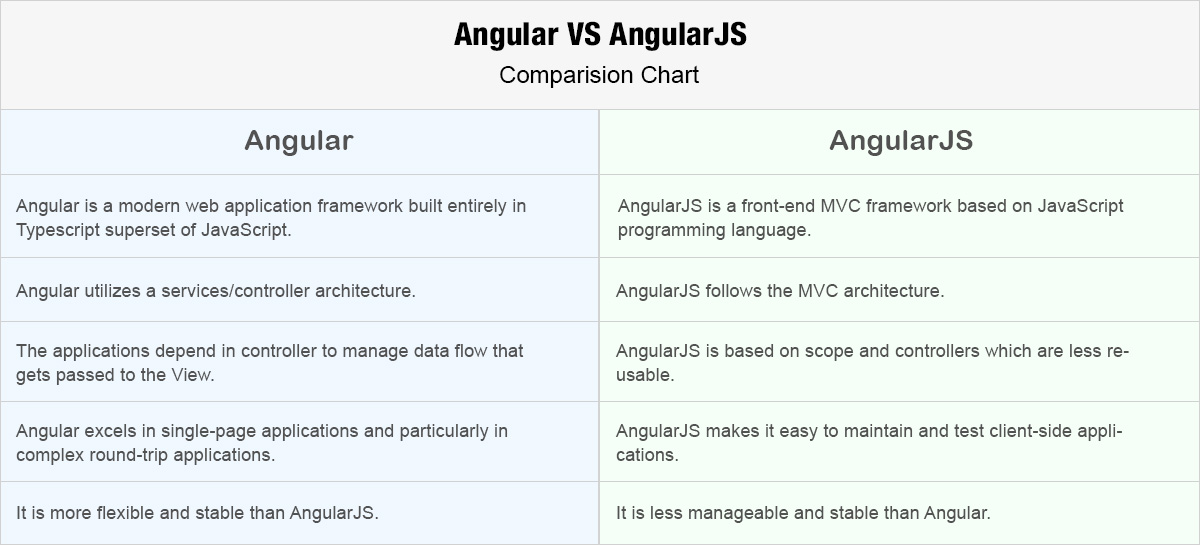In today's highly competitive digital landscape, businesses are always searching for strategies that can help them stand out from the crowd. With the rapid growth of technology and the increasing use of cloud computing solutions, creating web and mobile applications has become a basic requirement and a useful marketing tool for any successful company. These applications not only help businesses reach their target audience but also offer a responsive user experience.
When it comes to front-end web development, Angular and AngularJS are two of the most popular frameworks in use today. They are both developed and maintained by Google and have gained immense popularity among developers worldwide. However, there are differences between the two that are important to understand. But before diving into those differences, it is essential to have a good understanding of the approaches of both frameworks.

What is the Angular Framework?
The Angular framework is a free and open-source front-end framework that boasts a modular architecture written in HTML and TypeScript. With its backward compatibility and straightforward foundation for building new applications, Angular empowers developers to innovate and create with ease. Plus, the framework offers a wealth of reactive programming-friendly templates and resources to supercharge your app development process.
What is AngularJS Framework?
AngularJS is a framework for creating dynamic, single-page cloud computing solutions written in JavaScript. AngularJS is a free and open-source front-end framework that makes use of HTML as its template language. AngularJS was originally aimed at the design community since it offers front-end developers a complete solution without the requirement for additional plugins or frameworks. AngularJS's built-in, continually updated unit testing functionality makes it easy for developers to put their code through its paces in search of bugs.
Difference Between Angular and AngularJS Framework

# Architecture
Architecture refers to the overall structure and design of a system or application. In the context of custom software development, there are various frameworks and tools available to help developers create well-organized and modern web applications.
AngularJS follows the Model-View-Controller (MVC) architecture pattern. This means that the framework separates the application's concerns into three distinct components: the model, which represents the application's data; the view, which is responsible for displaying the data to the user; and the controller, which handles user input and updates the model and view as necessary.
Angular, on the other hand, is a more modern and powerful version of AngularJS. It uses a component-based architecture, where the application is built by combining individual, self-contained components that each handle a specific piece of functionality. Additionally, Angular also makes use of directives, which are markers in the HTML that allow developers to extend the functionality of the framework and create reusable components.
# Command Line Interface (CLI)
A Command Line Interface (CLI) is a text-based interface that allows users to interact with a computer program by typing in commands. The CLI provides a way for users to perform tasks and manipulate software without the need for a graphical user interface (GUI). CLI is commonly used in software development, system administration, and other technical tasks.
In web development, Angular JS is widely used for building web applications. However, it does not come with its own CLI, which means that developers need to rely on third-party CLIs to streamline their development process.
On the other hand, Angular, which is the successor of Angular JS, has its own CLI tool that is specifically designed to work with the framework. The Angular CLI provides a set of pre-defined commands that enable developers to create new components, services, and directives quickly and easily. This can significantly speed up the development process and help to ensure that all parts of the application are consistent and adhere to best practices. Overall, the Angular CLI is a powerful tool that can greatly enhance the developer experience and improve the quality of the resulting application.
# Language
In the context of computer programming, language refers to a formal set of instructions used to create software programs.
Frameworks and libraries are built on top of programming languages to provide developers with pre-built solutions for common tasks. Angular JS and Angular are both examples of the JavaScript framework.
Angular JS is an older version of Angular that uses HTML templates, while Angular is written in TypeScript, which is a superset of JavaScript that includes additional features from ECMAScript 6 (es6) to improve its performance. Both frameworks are designed to make it easier to create dynamic web applications with complex user interfaces.
# Routing
In web development, routing is a fundamental concept that allows a web application to display different content based on the URL or other criteria.
In the context of Angular JS, routing is configured using the built-in ( ) Route module. This module provides a route provider service that is used to define the routes for an Angular JS application. The route provider service allows developers to specify the URL paths, associated controllers, and views that are rendered for each route.
On the other hand, in Angular, routing is configured using the {()} route configuration. This configuration defines the URL path, the associated component, and any additional parameters or data required for the route.
# Structure Management
Structure management is an important aspect of custom software development, particularly in the context of web development frameworks such as AngularJS and Angular.
AngularJS powerful and versatile framework, but its structure can be less manageable compared to Angular. This is because AngularJS relies heavily on controllers, which can lead to an over-reliance on global variables and a lack of clear separation between concerns. This can make it difficult to manage larger applications, as the structure can become convoluted and difficult to navigate.
In contrast, Angular has a more robust and well-defined structure that makes it easier to manage larger applications. Angular relies on a modular architecture, which promotes a clear separation of concerns and makes it easier to organize and manage the various components of a web application. In addition, Angular uses a component-based architecture, which provides a more intuitive and easy-to-use structure for managing complex applications.
# Dependency Injection

Dependency Injection (DI) is a design pattern commonly used in software engineering that allows objects to receive dependencies from external sources rather than creating them internally. This design pattern helps to decouple components and makes the code more modular and maintainable.
In Angular, DI is taken to the next level with the use of Hierarchical Dependency Injection (HDI). HDI allows for a hierarchy of injectors that can be used to provide dependencies to components. This helps to boost app performance by reducing the amount of work that needs to be done by the injector, as well as providing more granular control over how dependencies are managed and shared.
In Angular, dependencies are defined using declarations, providers, and constructor functions. Declarations tell Angular which components are available for injection, providers are used to create new instances of objects for injection, and constructor functions are used to inject dependencies into components.
# Mobile Support
Mobile support refers to the ability of a software framework, tool or application to function effectively on mobile devices, such as smartphones and tablets.
In the case of AngularJS, the framework does not have native mobile app solutions support. This means that AngularJS applications may not be optimal for mobile development, as they may not be optimized for smaller screens or touch-based input methods. However, there are ways to make AngularJS applications more mobile-friendly, such as using responsive design techniques and leveraging third-party libraries and tools that can help optimize the application for mobile devices.
On the other hand, Angular, the newer version of the Angular framework, does have mobile app solutions support. This means that Angular mobile solutions are designed to work seamlessly on mobile devices, with support for popular mobile browsers such as Chrome, Safari, and Firefox.
# Performance
AngularJS uses a two-way binding process to synchronize the data between the view and the model. This process continuously checks for changes in the scope variables using the digest cycle, which can potentially slow down the application's performance.
On the other hand, Angular, which is a complete rewrite of AngularJS, is designed to be faster and more efficient. Angular uses a unidirectional data flow architecture based on the Flux pattern. This architecture makes it easier to manage the application state and ensures that only the necessary components are updated when data changes. This approach significantly reduces the number of times the digest cycle needs to run, improving the application's performance.
It is good to note that Angular JS uses controllers, while the rewrite of it is component-based. And since the scope of controllers is over, they are replaced by components.
N/B, Angular, does not have backward compatibility with AngularJS.
Angular Features
- Supports data binding
- It has an MVW
- It comes with an inbuilt template engine
- It supports hierarchical Dependency Injection.
- It is a highly scalable framework since it's modern and faster.
- If you are still trying to figure out which is better than the other, the pros and cons of Angular vs. AngularJS might be helpful.
Angular: Pros
- Due to its component-based architecture and better data binding algorithm, Angular has faster performance.
- The independent components that this framework uses get easily replaced or maintained.
- The inbuilt extensions in Angular's server side allow the developers to sync both the front and backside of content.
- The use of TypeScript language results in cleaner code, improved navigation, and top-quality products.
- Applications in the Angular framework can also work on mobile devices and browsers.
- Since Angular's components are independent, they are test-friendly and reusable.
Angular: Cons
- As most developers are not conversant with TypeScript, they find it to have a steep learning curve.
- The management of Angular's components is quite complicated.
- Although most engineers appreciate the command-line interface, they do complain that the documentation is incomplete.
Angular JS: Pros
- JavaScript, which is the language used in this framework, makes it easier for developers to learn the structure.
- AngularJS architecture of MVC and MVVM separates the design and data, making complex web development more straightforward.
- Organized coding makes the framework's codes reusable.
- There is faster coding support and prototyping in AngularJS, which results in improved development time.
Angular JS: Cons

- A developer who is not familiar with MVC architecture, cannot use this framework.
- A developer can only use the system with JavaScript; if it gets disabled, it cannot run.
- The DI feature and directives can get complicated for a developer used to traditional methods. One spends a lot of time learning or ends up hiring someone knowledgeable.
- If you are new to the framework, you will find the scope debugging to be quite complicated.
Conclusion
In conclusion, you can see a lot of improvement in Angular. It is faster and more efficient. So, Angular vs. AngularJS, which one to pick? As per the StackOverflow Developer Survey done in 2018, both were second-most-used-technology in Libraries and frameworks. Although the number may have changed, 36.9 per cent of engineers said they were using both Angularjs to create dynamic user interfaces.
Call us at 484-892-5713 or Contact Us today to know more details about the vital distinctions between Angular vs. AngularJS.



